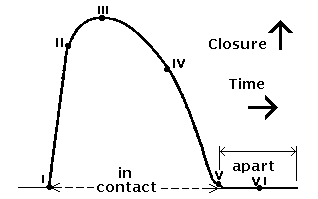Please note that this information is still under development.
Interpreting Lx waveforms
- The normal Lx waveform can be related to vocal fold vibration:

Vocal fold closure sequence.

Laryngograph waveform.
Notes:
- The closure/opening sequences are regular. Normal vocal folds
have similar mass, shape and stiffness.
- The folds close faster than they open (the Bernoulli
effect). The rising edges on the Waveform are steeper
than the falling edges.
- Each cycle exhibits a similar shape for the closure-opening
sequences.
- Lx waveforms provide the basis for a physical
interpretation of pathological voice conditions. The following are some
of the features which can be investigated: vibration REGULARITY;
CLOSURE definition, OPENING definition; OPEN/CLOSE phase ratio;
CLOSURE/OPENING sequence shape, and these in turn can indicate
vocal fold: MASS asymmetry SHAPE asymmetry; STIFFNESS asymmetry; the
POSITION of nodules or polyps (in a vertical plane); and whether
treatment/therapy is affecting a return towards normality.
Some examples of pathological waveforms:
 IRREGULARITY, STIFFNESS, ASYMMETRY.
IRREGULARITY, STIFFNESS, ASYMMETRY.

 CLOSURE/OPENING sequence shape is
non-normal, MASS - SHAPE ASYMMETRY.
CLOSURE/OPENING sequence shape is
non-normal, MASS - SHAPE ASYMMETRY.
Calibration technique for the Laryngograph
The Laryngograph monitors vocal fold closure by measuring variations In
the conductance between a transmitting electrode delivering a high
frequency signal to the neck on one side of the larynx and a
receiving electrode on the other side of the larynx. The opening and
closing of the vocal folds, by varying the conductivity of the path
between the electrodes causes an amplitude modulated version of the
transmitter signal to reach the receiving electrode. The Laryngograph
demodulates this signal and thus derives a waveform representing the
variations in conductance. The relationship between this waveform the
vocal fold opening and closure cycle is thoroughly documented
elsewhere.
Calibration of the Laryngograph involves the use of a
dummy neck; an electrical circuit designed to model the
conductivity of the neck and the modulation of this
conductivity by the vibration of the vocal folds. In
the dummy neck the conductivity of the circuit is
modulated directly by an electrical signal. Comparison of
the modulating signal with the consequent Laryngograph
output makes possible all the standard test procedures
for deriving the response of a circuit in the frequency
or time domains. See attached frequency, phase and time
responses for the Laryngograph with normal, fast and Gx
time constants.
A further calibration and correction technique is
available when the laryngograph waveform can be digitised
and stored and processed by a computer. The laryngograph
"Waveforms" software and A-D unit include a program for
low frequency phase distortion calibration and correction.
This program can be used to correct low
frequency phase distortions of the time domain waveform
whether introduced by the Laryngograph or by any
recording apparatus. Essentially this technique involves
comparison of the waveform output by the system being
calibrated with a rectangular waveform used as the
reference input waveform. Fourier series expansions are
made of the distorted and ideal waveforms, and the
magnitude and phase ( and hence phase delay ) of each of
the first sixty four harmonics found. By comparing the
two sets of phase delays, an algorithm determines the
delays suffered by the components of the distorted
waveforms. A model of the phase distortion is produced
in the form of two filter parameters, which, when
converted to digital filter coefficients can be used for
correction purposes. The result is a Laryngograph
waveform which can be used to determine with certainty
features such as the exact point of vocal fold closure.


 IRREGULARITY, STIFFNESS, ASYMMETRY.
IRREGULARITY, STIFFNESS, ASYMMETRY.

 CLOSURE/OPENING sequence shape is
non-normal, MASS - SHAPE ASYMMETRY.
CLOSURE/OPENING sequence shape is
non-normal, MASS - SHAPE ASYMMETRY.